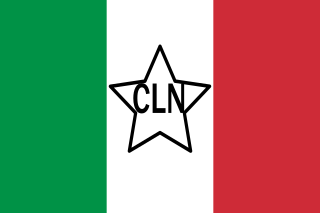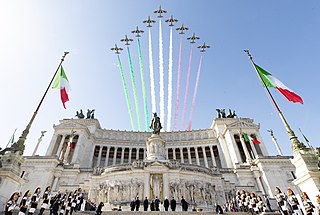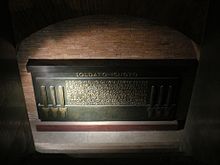
An institutional referendum was held by universal suffrage in the Kingdom of Italy on 2 June 1946, a key event of contemporary Italian history. Until 1946, Italy was a kingdom ruled by the House of Savoy, reigning royal house since the unification of Italy in 1861 and previously rulers of the Kingdom of Sardinia. In 1922, the rise of Benito Mussolini and the creation of the Fascist regime in Italy, which eventually resulted in engaging the country in World War II alongside Nazi Germany, considerably weakened the role of the royal house.

A Tomb of the Unknown Soldier or Tomb of the Unknown Warrior is a monument dedicated to the services of an unknown soldier and to the common memories of all soldiers killed in war. Such tombs are located in many nations and are usually high-profile national monuments. Throughout history, many soldiers have died in war with their remains being unidentified. Following World War I, a movement arose to commemorate these soldiers with a single tomb, containing the body of one such unidentified soldier.

The national flag of Italy, often referred to in Italian as il Tricolore, is a tricolour featuring three equally sized vertical pales of green, white and red, national colours of Italy, with the green at the hoist side, as defined by article 12 of the Constitution of the Italian Republic. The Italian law regulates its use and display, protecting its defense and providing for the crime of insulting it; it also prescribes its teaching in Italian schools together with other national symbols of Italy.

Giulio Monteverde was an Italian naturalist sculptor and teacher.

Public holidays in Italy are established by the Italian parliament and, with the exception of city or community patronal days, apply nationwide. These include a mix of national, religious and local observances. As for Whit Monday, there is an exception for South Tyrol. In Italy there are also State commemoration days, which are not public holidays.

The Italian resistance movement is an umbrella term for the Italian resistance groups who fought the occupying forces of Nazi Germany and the fascist collaborationists of the Italian Social Republic during the Second World War in Italy from 1943 to 1945. As a diverse anti-fascist movement and organisation, the Resistenza opposed Nazi Germany, as well as Nazi Germany's Italian puppet state regime, the Italian Social Republic, which the Germans created following the Nazi German invasion and military occupation of Italy by the Wehrmacht and the Waffen-SS from 8 September 1943 until 25 April 1945.

The Victor Emmanuel II National Monument, also known as the Vittoriano or Altare della Patria, is a large national monument built between 1885 and 1935 to honour Victor Emmanuel II, the first king of a unified Italy, in Rome, Italy. It occupies a site between the Piazza Venezia and the Capitoline Hill. The monument was realized by Giuseppe Sacconi.

Piazza Venezia is a central hub of Rome, Italy, in which several thoroughfares intersect, including the Via dei Fori Imperiali and the Via del Corso. It takes its name from the Palazzo Venezia, built by the Venetian Cardinal, Pietro Barbo alongside the church of Saint Mark, the patron saint of Venice. The Palazzo Venezia served as the embassy of the Republic of Venice in Rome.
Maria Bergamas was an Italian woman who was chosen to represent all Italian mothers who had lost a son during World War I not knowing where he was buried.

Festa della Repubblica is the Italian National Day and Republic Day, which is celebrated on 2 June each year, with the main celebration taking place in Rome. The Festa della Repubblica is one of the national symbols of Italy.

The Stella d'Italia, popularly known as Stellone d'Italia, is a five-pointed white star, which has symbolized Italy for many centuries. It is the oldest national symbol of Italy, since it dates back to Graeco-Roman mythology when Venus, associated with the West as an evening star, was adopted to identify the Italian peninsula. From an allegorical point of view, the Stella d'Italia metaphorically represents the shining destiny of Italy.

Basilica di Santa Maria Assunta is the principal church in the town of Aquileia, in the Province of Udine and the region of Friuli Venezia Giulia, Italy.

National symbols of Italy are the symbols that uniquely identify Italy reflecting its history and culture. They are used to represent the Nation through emblems, metaphors, personifications, allegories, which are shared by the entire Italian people.

The Pistoia Brazilian war cemetery is a former Second World War cemetery located in Pistoia, Toscana, Italy. The cemetery site honors Brazilian soldiers who died in Italy during World War II, the remains of whom were buried here until 1960.

Liberation Day, also known as the Anniversary of Italy's Liberation, Anniversary of the Resistance, or simply 25 April, is a national holiday in Italy that commemorates the victory of the Italian resistance movement against Nazi Germany and the Italian Social Republic, puppet state of the Nazis and rump state of the fascists, during the liberation of Italy and the Italian Civil War during World War II. That is distinct from Republic Day, which takes place on 2 June and commemorates the 1946 Italian institutional referendum.

National Unity and Armed Forces Day is an Italian national day since 1919 which commemorates the victory in World War I, a war event considered the completion of the process of unification of Italy. It is celebrated every 4 November, which is the anniversary of the armistice of Villa Giusti becoming effective in 1918 declaring Austria-Hungary's surrender.

The Polo Museale del Lazio is an office of Italy's Ministry of Cultural Heritage. Its seat is in Rome in the Palazzo Venezia.

Xi Jinping's visit to Italy and France was a state visit of President and General Secretary Xi Jinping of China to Italy and France from 21–26 March 2019. It was his second trip to the Southern European region in five months, the first state visit to Italy and France in 10 and 5 years respectively and his first foreign trip of 2019. It also coincided with the 55th anniversary of the establishment of China-France relations in 1964. During the visits, Xi met with Emmanuel Macron and Giuseppe Conte, the President of France and Prime Minister of Italy respectively. The two visits were part of a bigger European trip by Xi which also included a visit to Monaco to meet with Albert II, Prince of Monaco. A topic that came up in both visits was the Belt and Road Initiative.

The Anniversary of the Unification of Italy is a national day that falls annually on 17 March and celebrates the birth of Italy as a modern nation state, which took place following the proclamation of the Kingdom of Italy on 17 March 1861.

The 13th Signal Battalion "Mauria" is an inactive signals unit of the Italian Army last based in Portogruaro in Veneto. Formed during the 1975 army reform the battalion was named for the Mauria Pass and assigned to the 3rd Missile Brigade "Aquileia". The regimental anniversary falls, as for all signal units, on June 20, the height of the Second Battle of the Piave River in 1918.

 Click on the map for a fullscreen view
Click on the map for a fullscreen view




















